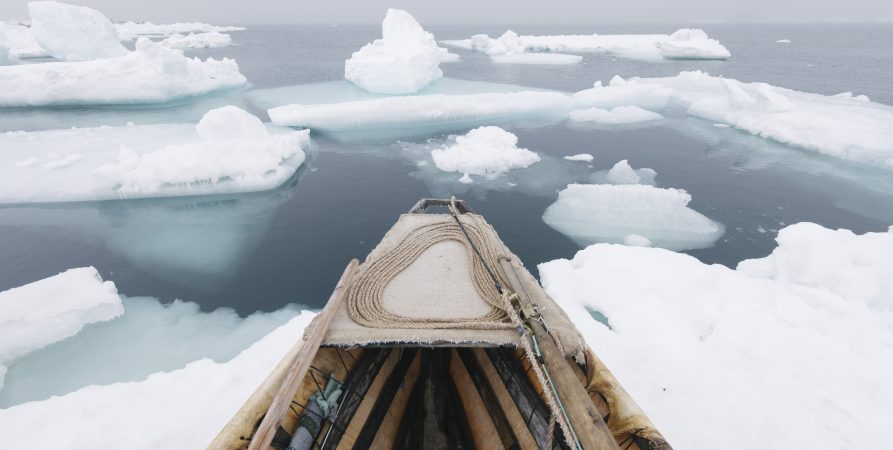Needle case with morphed face and body
Life Story
Curator Amber Lincoln points out that needles and needle cases are ‘the most important technology in the Arctic’. [1] Arctic ancestors have used needles and needle cases for over 30,000 years as illustrated by mammoth ivory needles excavated at the Yana RNS site in Siberia. [2] Needle cases are crucial to protect the delicate needles of various sizes and for various purposes. This is also reflected in the cosmological or spiritual expressions with anthropomorphic or zoomorphic motives common in needle cases across the Arctic.
This particularly striking walrus ivory needle case from Sivuqaq (St. Lawrence Island) amplifies the intricacy of needle cases. The carver incorporates a morphed face attached to an animal (perhaps a caribou? which would reflect a connection with the Siberian Yupiit relations). The nose, mouth, belly, elbows, side of the legs, and the feet (or hooves?) are of a lighter colour to provide contrast and accentuate the specific body parts. The face has a swollen and dislocated right eye. Distorted faces are common in Inupiat masks [see also SVCA object text 111] and show the encountered tungai (‘spirits or souls of dead men or animals’). [3] Perhaps this needle case can be understood in similar terms, and with some reservation we could conclude that special needles were kept in this needle case. Needles that were likely used to make belongings of an aŋatquq. Yet, another interpretation has been that this needle case represents birthing. [4]
The provenance is unknown but thought to be Thule (1200-1800 AD) or Yupiit who carved it in the 19th Century on Sivuqaq. [5] The date of the object, however, still needs to be further analysed and verified. The object is recorded to have been found at the Old Village at Cape Kialegak – Kiyalighaq or Kialighaq [6] – on the south-eastern point of Sivuqaq near to the Punuk Islands. This would place the object in the Old Bering Sea-Okivik (500-750 AD) or Punuk (800-1200 AD) era rather than Thule or Yupiit. [7] Whatever age the needle case might be and for whatever purpose, one thing is certain: this captivating case protected that uttermost important part of Arctic life: the needle.
Peter Loovers, February 2022
[1] Amber Lincoln in ‘In from the Cold: Five Sainsbury Centre Treasures at the British’, (2020), https://www.sainsburycentre.ac.uk/stories/in-from-the-cold/ [accessed 06 December 2021]
[2] Vladimir V. Pitulko, ‘The Earliest Arctic Settlers’, in Arctic: culture and climate, ed. by Amber Lincoln, Jago Cooper, and Jan Peter Laurens Loovers (London: Thames & Hudson in collaboration with The British Museum, 2020), pp. 150-165 (p. 158-59)
[3] Vanstone, James. 1969. Masks of the Point Hope Eskimo. Anthropos, Nomos 63/64(5-6): Pp. 828-840
[4] Mikhail M. Brohshtein (translated by Richard L. Brand), ‘Early Eskimo Art from Ekven and Bering Strait’, In Gifts from the Ancestors: Ancient Ivories of the Bering Strait, ed. by William W. Fitzhugh, Julie Hollowell, and Aron L. Crowell (Princeton: Princeton University Art Museum, 2009), pp. 138-161 (p.154, fig. 2.2).
[5] For Thule, see Mikhail M. Brohshtein (translated by Richard L. Brand), Early Eskimo Art from Ekven and Bering Strait. In Gifts from the Ancestors: Ancient Ivories of the Bering Strait, ed. by William W. Fitzhugh, Julie Hollowell, and Aron L. Crowell (Princeton: Princeton University Art Museum, 2009), pp. 138-161 (p.154, fig. 2.2); for Yupiit, see Amber Lincoln in ‘In from the Cold: Five Sainsbury Centre Treasures at the British’, (2020), https://www.sainsburycentre.ac.uk/stories/in-from-the-cold/ [accessed 06 December 2021].
[6] Crowell, Aron L. and Estelle Oozevaseuk. 2006. The St. Lawrence Island Famine and Epidemic, 1879-80: A Yupik Narrative in Cultural and Historical Context. Arctic Anthropology, 43(1): pp. 1-19. p. 6, 8.
[7] Henry B. Collins, Jnr., Prehistoric Art of the Alaskan Eskimo, (Washington: Smithsonian Institute, 1929), p.16.
Provenance
Purchased by the Sainsbury Centre, University of East Anglia from Anthony Plowright on the advice of Robert Sainsbury in 1994 out of funds provided by the Robert and Lisa Sainsbury Charitable Trust.
Not on display
Title/Description: Needle case with morphed face and body
Object Type: Implement
Materials: Walrus ivory
Technique: Carving, Drilling
Measurements: h. 66 x w. 23 x d. 19 mm
Accession Number: 1105
Historic Period: Thule (1200 - 1800 AD) or 1800s - 1900s
Production Place: Alaska, Gambell, North America, Old Village, St. Lawrence Island (?), The Americas
Cultural Group: Thule or St. Lawrence Yupiit
Credit Line: Purchased with support from the Robert and Lisa Sainsbury Charitable Trust, 1994
In from the Cold: Five Sainsbury Centre Treasures at the British Museum
Objects from the Centre’s collection offer snapshots of life in the Arctic
Continue reading







